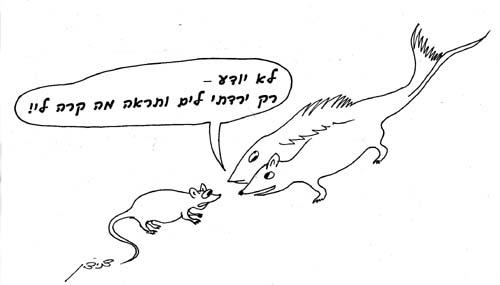
According to the laws of the Torah there are eight types of vermin that convey ritual impurity to those who touch their corpses, causing that person to require immersion for purification. It is written: “These also shall be unclean to you among the creeping things that creep on the earth: the mole, the mouse, and the large lizard after its kind; the gecko, the monitor lizard, the sand reptile, the sand lizard, and the chameleon [though the Hebrew word is the same, this is not the white owl mentioned in Leviticus 11:18): These are unclean to you among all that creep. Whoever touches them when they are dead shall be unclean until evening” (Leviticus 11:29-31). The early sages (Tanaaim) ruled that even a mouse created from the dirt, in the developmental stage at which it is half flesh and half dirt is part of the group of mice which impurify — but they disagreed about one who touches the dirt half of this mouse. One of the sages ruled that a person who touched the dirt is pure and another ruled that even if he touches the dirt he has been impurified. Another sage, Rabbi Joshua son of Levi, added conditions and stated that the development of the mouse from the dirt had to be symmetrical — along the mouse’s length and not its width. The sages also discussed whether the sea mouse is a mouse at all, one of the type specified in the Torah as an impurifying vermin. What are the issues under debate? On one hand, just as any animal called a “mole” impurifies, for there is no sea mole, only moles which grew on dry land, so the rule should be for the mouse, that any animal called “mouse” should impurify, so the sea mouse should also impurify, bearing the name “mouse.” On the other hand, just as only land-based moles impurify — because there are no sea-based moles — so the rule should be for mice; only a mouse which grows on land impurifies, and this excludes the sea mouse. This doubt was settled from the phrase “on the earth,” implying that only a land-based mouse impurifies and not the sea mouse. They continued to ask: Could the words “on the earth” be interpreted to mean that even a land-based mouse which went to sea does not impurify unless one touches it when it is on dry land? Answer: Since it is written “the creeping things,” it means any place the vermin lives, even if it has gone down to the sea.
The sages also discusses the origin of the mouse which is formed from the dirt, which during its development is half flesh and half dirt and is considered a mouse which can impurify. What are the issues under debate? On one hand, it should be compared to a mole: just as the mole impurifies because it reproduces sexually — the mole is not created out of dirt — so only the mouse which reproduces sexually impurifies, excluding the mouse made of dirt, which does not sexually reproduce. On the other hand, it could be compared to a mole in that every animal called “mole” impurifies — the mole is not created from dirt — thus ant animal called “mouse” impurifies, including a mouse which is half flesh and half dirt and which is called “mouse.” This doubt was resolved based on the phrase “the creeping things,” including the mouse formed from dirt with not sexual reproduction.
(Babylonian Talmud, Tractate Chulin 126b-127a)
